Suppose you want to do a project in record time—what do you do? Do you just wing it? Or do you plan everything beforehand? To answer these, you need to break down agile vs scrum; that is, you have to know what sets each one apart.
In project management, the agile methodology is a way to “wing it.” As its name implies, agile allows all the participants in the project to react quickly and appropriately as the need arises. This method, which is now supported by various project management software platforms, makes a project flexible enough to accommodate changes even if the team is currently at work on it.
Agile is only one project management method, however, of which there are many. And agile itself has given rise to modified processes, including kanban and scrum. In this article, we explore in-depth what agile can do for your business—and how scrum can further refine your agile-ready platform.

Agile and Scrum: Making the Distinction Table of Contents
First of all, the difference between agile and scrum is like how “number” differs from “two.” Two is one number. In the same vein, scrum is a subset of agile, which, in turn, is a type of project management method.
Agile and all its other subtypes are becoming the gold standard in project management. According to PwC, projects using the agile method succeed 28% more than standard projects or projects using other methodologies.

That said, while it’s enjoying great growth and widespread adoption, the waterfall methodology is still the most prevalent in use today. Other companies, however, also combine the principles of both agile and non-agile approaches.
A comparison of agile and scrum—or the nuances thereof—will not be possible, however, unless we start from the very beginning.
Why do projects need to be managed? And secondly, why are there so many ways to maintain, manage, and direct such a project? And finally, what is agile methodology and how it works?
Why project management?
Understanding project management and what it can do is crucial. 46% of organizations in 2013 don’t see the value in it, but reports are clear that strategic initiatives employing project management see a 16% higher success rate. This is because most high-level executives think project management is an unnecessary expense when they could simply oversee the project themselves.
However, project management brings a sharp focus on the unique requirements and circumstances of the project that general management would likely overlook. Besides, mismanagement of a project can lead to project failure. It’s estimated that for every US$1 billion spent on projects, US$122 million is wasted because of poor project management. Also, the scope, schedule, and costs of project management vastly differ from the routine processes of any given company.
This is why several approaches to make project management more efficient and effective have emerged in the last two decades. We condensed them into three categories: predictive, agile, and hybrid.
Source: Project Management Institute
Key takeaways
- 46% of organizations don’t see the value of project management, but it confers a 16% higher chance of success on projects that use it (Project Management Institute).
- US$122 million are wasted for every US$1 billion spent on project management because projects are handled poorly (Hive).
- There are three main ways to handle a project: using a predictive approach, employing an agile methodology, and combining the two.
What is agile?
Agile methods, also called “adaptive planning”, are flexible and can react to changing circumstances.
The 2018 CHAOS report by The Standish Group cited that agile projects are three times as likely to succeed as waterfall projects. Conversely, waterfall projects are more than three times as likely to fail than agile.
This doesn’t mean, however, that agile is always the best way to handle a project. Some industries, like construction, can benefit from a waterfall method’s rigorous standards and consistent output.
How does it work?
An agile system breaks the project into more manageable chunks over an unspecified timeline. While predictive methods often have a strict schedule, agile projects believe in no such thing. Instead, it allows the team to work on smaller components of the project at a time (or simultaneously, depending on the agile strategy). This makes them more mobile to adjust their priorities as the situation requires.
There are different subsets under the agile methodology. These subsets use agile mechanics at their core—as outlined by the 12 principles of agile—but feature different modes and processes that suit a particular field. Some examples are scrum, kanban, crystal, and lean.
Predictive vs. agile
Predictive or “waterfall” project management is so-called because it’s a sequential process where progress moves downward. In a waterfall project, project managers specify milestones and strategies from the initial planning phase toward the fulfillment of a goal.
Many industries, or 47% of businesses worldwide, employ waterfall project management methods or some variant.
In contrast, agile is the opposite of a predictive approach. Unlike waterfall that tries to set a scope, schedule, and plans on the outset, agile management aims to minimize planning and instead gives teams the flexibility to respond to changing circumstances. This system is naturally counter to Waterfall because it fills the gaps in the latter’s shortcomings.
Most executives are confused about when to use agile or waterfall project management. Due to its nature, agile is best for projects that can change in development or whose parameters are in flux. In addition, because the final product of an agile project may look nothing like the original vision, it’s best for projects whose main thrust is in innovation.
On the other hand, Waterfall is excellent for objectives that are clear and known. This is useful when maintaining the standards for the anticipated result is much more important than flexibility. It’s also more appropriate for projects that have been explored or completed in the past and need to be redone.
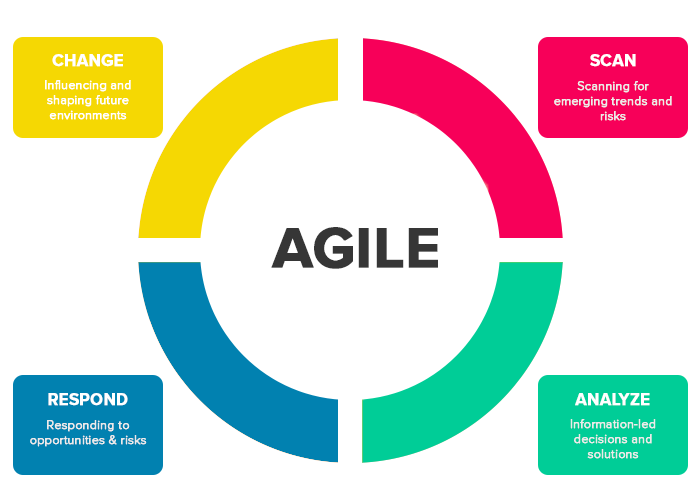
Source: Workamajig
Key takeaways
- Agile methodologies espouse a more mobile framework for project management and eschew traditional planning for flexibility and unspecified timelines.
- Projects using agile are three times as likely to succeed as a waterfall project (The Standish Group).
- That said, 47% of industries worldwide use waterfall project management (Project Management Institute).
- There are several, more refined processes using the agile framework, including scrum and kanban (CGI).
- Agile is best for projects with rapidly changing demands and whose main drive is innovation (SSI).
How about hybrid systems?
The Project Management Institute cites that over 1 in 2 projects use agile or hybrid approaches. These systems use principles of both waterfall and agile. Project managers do this in two ways: in parallel or mixed.
In a parallel scheme, a business may have multiple components or projects, with each using either an agile or waterfall method. This is a good way to hybridize a software company, for example. Development may use agile processes, while the other parts of the business, such as consulting, may use waterfall. Another parallel scenario includes a single project whose certain parts may use agile and others predictive.
On the other hand, a mixed (or truly hybrid) project management system combines both. This scenario may work in different ways, such as high-level planning with agile direction or the other way around. In most cases, hybrid projects often use traditional styles in clearer parts of the project, while agile in unclear ones (or areas where there is room for innovation).
Certain parts of scrum can also be considered hybrid in this sense, especially as scrum’s sprint goals cannot be changed once initiated. In effect, sprints are traditional, but planning the goal of the next sprint—as well as the daily scrum meetings to refocus day-to-day processes—is agile.
Source: VersionOne 2017
Key takeaways
- Over 1 in 2 projects use agile or hybrid systems (Project Management Institute).
- Hybrid combines both predictive and agile management in two ways: running in parallel or in combination (The Project Group).
- Scrum can also be called a hybrid method (The Project Group).
An overview of scrum
This brings us to the main topic: how does scrum differ from agile? And is agile part of scrum?
For the first question, they don’t, at least in general. Scrum is a subset of agile, which means it’s a refinement of agile principles and mechanisms. Secondly, agile is both part of scrum and not. Scrum uses agile (which makes it a part of scrum), but it’s not part of agile in the sense that it’s the other way around—scrum is simply a type of agile process.
Scrum has a slightly different way of applying agile to project management. Here’s a deeper look.
What is scrum?
Software development is one of the first industries to use scrum, but it’s simple—and agile—enough for other sectors. The official Scrum Guide says that unlike agile, which can be referred to as a process, scrum is a framework. This means you can use other processes and techniques while still using scrum.
Scrum is simple and lightweight. It’s based on empiricism, which assumes that knowledge comes from experience and known variables. The team can use empiricism to benefit from each other’s experience and apply it to the next sprint or even the next working day.
Scrum roles
Scrum is different from most agile implementations because the team itself shares the traditional duties of a project manager. This makes a project manager redundant and gives the team a collective sense of ownership. A scrum team is thus self-organizing and self-managing.
A typical software development scrum team has three roles:
- Product owner
- Scrum master
- Developers
The product owner’s role is self-explanatory. This person has the overall vision of the project and maintains the product backlog. The product owners also works closely with the scrum team after each sprint to see what can be removed, modified, and/or added to the project.
The scrum master, meanwhile, roughly corresponds to a project manager in a typical agile environment, although their main focus is different. Unlike a project manager whose success is predicated on the success of the project, a scrum master instead focuses on the team and the process.
Finally, the developers execute the tasks outlined for that sprint, known as the sprint backlog. Unlike other project management styles where each one has specific roles, a scrum team’s developers are cross-functional. This means they share each other’s workloads (such as coding and testing). A scrum master is also a developer.
Scrum also esteems five values, which are central to the success of any project using scrum. These scrum values are the courage to do the right thing every time, a focus on the sprint, a commitment to the sprint goals, respect for each member of the team, and openness with one another. Without these values, a scrum’s main strength—which is trust—won’t work.
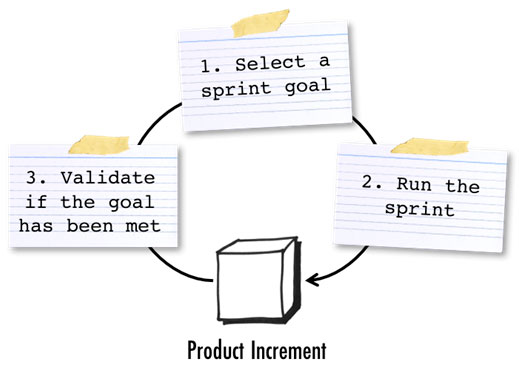
Source: Roman Pichler
How scrum works
What is the core purpose of scrum? This is a common question often asked, but it can be distilled simply to the statement: to deliver incremental or iterative results in 2-3 weeks using a self-managing team collective. And it does this by using agile concepts.
Scrum assumes that project requirements aren’t always known at the start of a project. This allows a product owner to work with the development team to create a product backlog. A product backlog contains a list of features that make a minimum viable product (MVP). These will be often subdivided into smaller components that can be worked on in increments called a “sprint backlog” (i.e. a list of items on the product backlog that can be humanly done in 2-3 weeks).
The team will work on the sprint backlog for the next 2-3 weeks. This is one whole work cycle, where the team goes to tackle what’s on the backlog. Scrum is set up in a way that sprints can’t accommodate changes once the team has “signed up” for that sprint; changes have to be made on the next one.
Every day during a sprint, the team usually does a 15-minute meeting, or “scrum” (from where it got its name), before the work day begins. This is where they review yesterday’s progress or exchange stories while working on the sprint. Scrums update each other on where they’re at in the sprint and refocuses them for the remaining tasks.
Finally, when the sprint is done, the product owner will check if the requirements of the sprint backlog have been met. Once it’s validated, the team will review how they performed in the last sprint and look for ways to improve the process. The product owner will then update the backlog and reprioritize their process as needed.
Key takeaways
- Scrum is a subset of agile, or a framework that implements agile processes.
- A scrum team has three roles—product owner, scrum master, and developers—that work together by learning from each other.
- Work is done in 2- or 3-week cycles called sprints, after which the project is reassessed and refocused for the next sprint.
- Each sprint delivers an iteration of the product to the owner and stakeholders in incremental builds.
Scrum tools
Scrum is the most popular agile framework in use today. According to Scrum Star Academy, scrum commands 56% of the agile methodology market. It’s even as high as 64%, if you count the scrum-kanban hybrid called “scrumban” (which has an 8% share).
Managing a scrum team can be as simple as using a whiteboard, a marker, and a few post-it notes. This kind of low-tech is reliable and homey, but doesn’t always fit the requirements of every team. If you have remote teams, for example, you may want to look at more modern solutions.
In this section, we talk about three of our top software solutions that allow you to maximize your scrum teams. All these are SaaS-enabled, so you can access them wherever, whenever, and however you choose.
monday.com
You will no longer fear Mondays with monday.com’s full support for scrum methods. monday.com has a unique board system that you can tailor to your scrum style, and rightly so. It’s one of the best project management software for customization, as everything in the application can be customized for the necessities of your business.
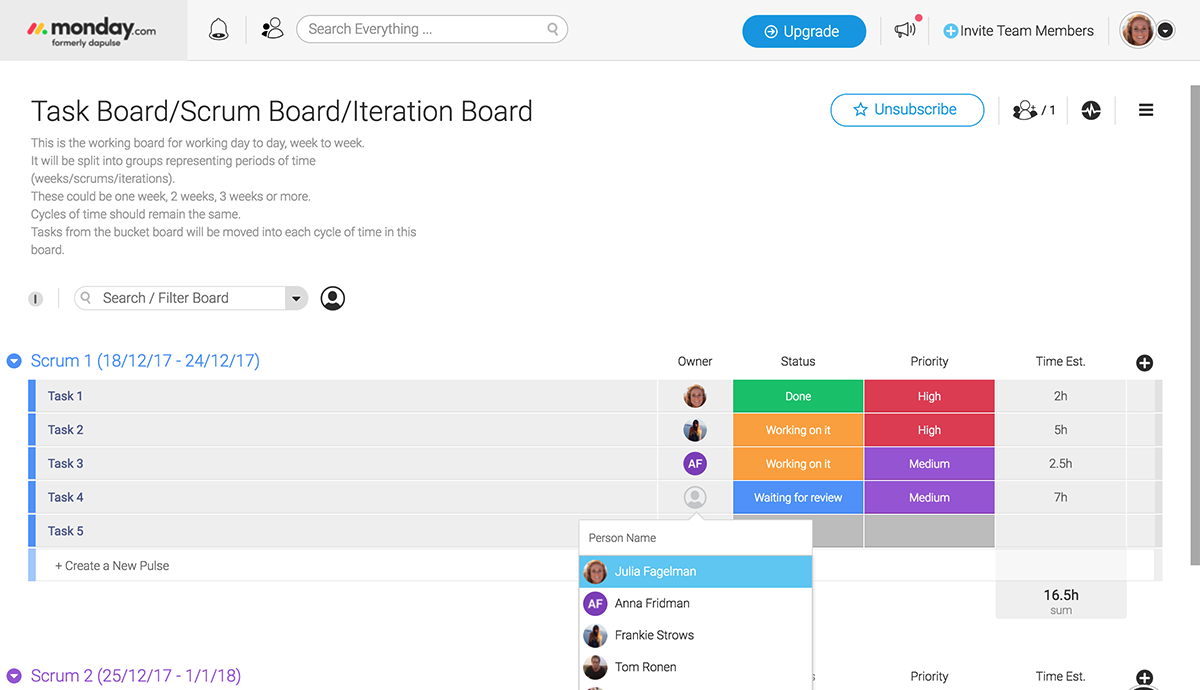
monday.com allows customizing the tool for a scrum workflow.
And like highly rated project manager tools, monday.com has a whole suite of collaborative utilities and integrations, plus easy access for those even without a monday.com account so you can invite select customers and stakeholders for your sprint planning sessions.
You can use all the features for free for a period of time to see if the software matches your needs. Simply sign up for a monday.com free trial here.
Wrike
Wrike is one of the best project management and collaboration tools out there. And like many of its contemporaries, Wrike also supports scrum management. Wrike has a user-friendly interface that features a singular hub for all your work.
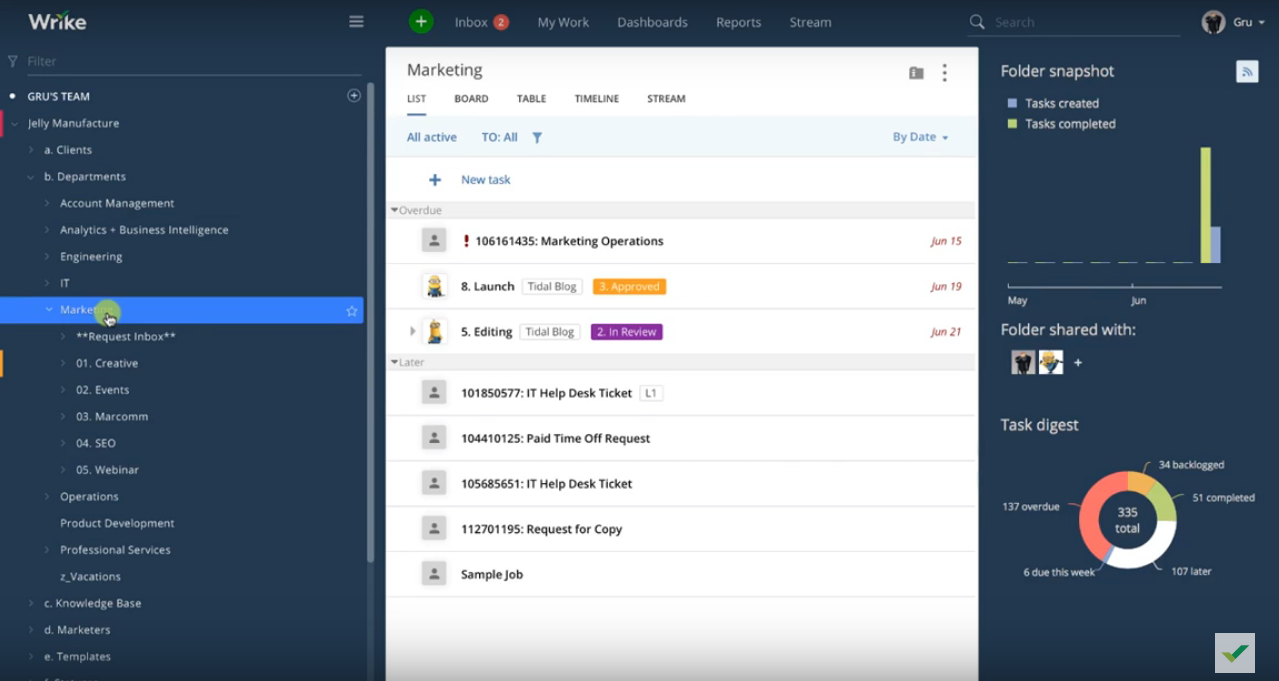
Wrike’s user-friendly UI allows users to manage their scrum tasks easily.
You can leverage the simplicity and leanness of scrum with Wrike’s tools, allowing you to put customers as part of the scrum team for more in-depth feedback. Plus, Wrike’s process is highly transparent, where all members of the team—from product owner to the customers and stakeholders—receive progress updates.
The vendor offers a comprehensive free trial to get you up to speed with the features. You can sign up for Wrike free trial here.
Smartsheet
Last but certainly not least, Smartsheet is a spreadsheet-based project management tool that looks deceptively simple. The application, however, allows you to customize this look and the functionalities of your sheet to a full-fledged scrum board.
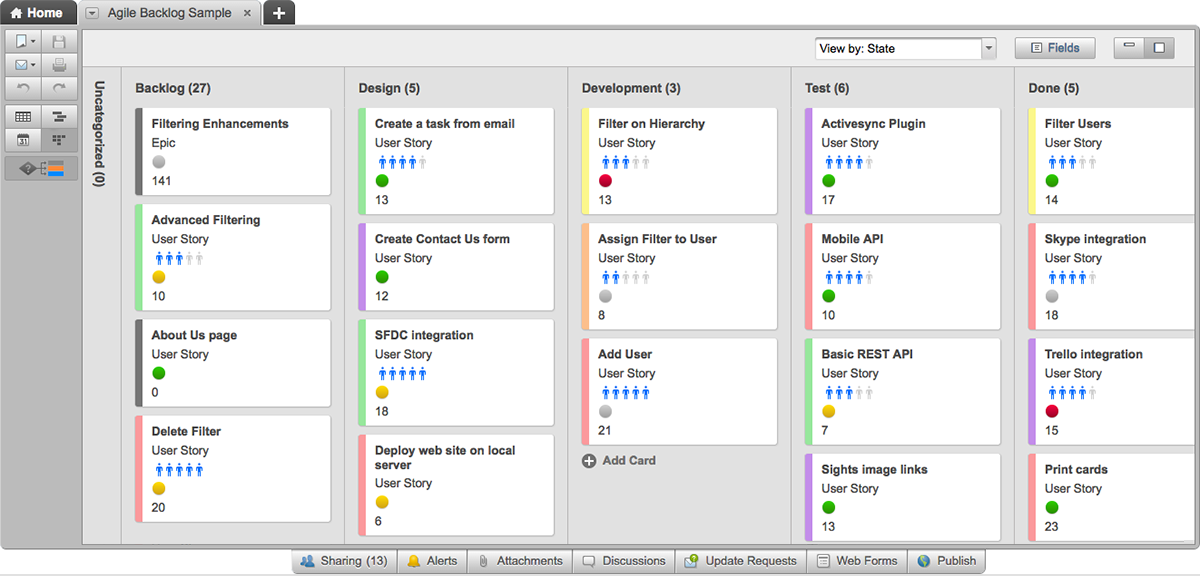
A screenshot of Smartsheet’s scrum support, here shown with an example of a product backlog.
Smartsheet’s powerful Card View allows for scrum integration, which can also be customized for other agile frameworks like kanban. It also supports the automation of everyday tasks, which makes it an all-in-one solution for the product owner, scrum master, or the development team.
You can use all the features for free for a period of time to see if the software matches your needs. Simply sign up for Smartsheet free trial here.
Using agile and scrum to refine your business strategy
For inexperienced project managers, making a distinction between when to use scrum or other methods may not seem clear-cut. Waterfall methods may be simple, but it’s not always the best approach. And the same goes for agile and scrum. Some industries are better off using a certain project management style and just because agile is growing doesn’t mean it’s a one-size-fits-all solution.
That means knowing your business needs or at least the requirements of your project takes prime importance. Make a checklist of what your project aims to do and what product you expect to roll out. If it’s a product that’s been known for a time, using waterfall methods will suffice. If, however, you need to innovate and time is not a constraint, your team will find it more beneficial to adopt an agile approach.
Even with agile, some methods may work better than others. For example, more than half of all organizations using agile adopt a scrum framework. This is because scrum offers simplicity and teamwork more than anything else, qualities welcome in a field that can employ agile in the first place. This is why most laymen think agile means scrum (or scrum means agile), when they have a significant distinction.
When choosing a tool, however, remember that collaboration is also an essential part of a project, especially scrum. Looking at collaboration software comparison may help nail down the application that suits your particular needs.
Using software tools like monday.com to automate daily tasks and organize your project is a big help. This applies to whether you’re using scrum or otherwise. And as mentioned earlier, you can test drive the software when you sign up for monday.com free trial here.




























Leave a comment!